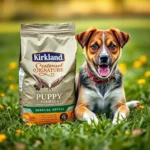
Introduction
Bloodhounds are an iconic breed, renowned for their incredible sense of smell and tracking abilities. With their loose, wrinkled skin and droopy ears, these dogs have distinctive physical traits that make them both charming and unique. Known for their friendly and affectionate nature, Bloodhounds are often considered gentle giants. However, being a large breed, they come with specific nutritional needs that are critical to their health and well-being. Proper nutrition is paramount, influencing not just their physical development but also their behavior.
Feeding your Bloodhound the best dog foods for Bloodhounds can significantly impact their overall health, energy levels, and longevity. This guide aims to help dog owners make informed decisions regarding the best dietary options for their Bloodhounds, focusing on the essential nutrients and ingredients that promote a healthy lifestyle.
Understanding Bloodhound Nutritional Needs
Nutritional Requirements
Bloodhounds, like all dogs, require a balanced diet consisting of essential nutrients. A well-rounded diet includes:
- Proteins: Vital for muscle development and repair, proteins are the building blocks of your Bloodhound’s body. Aim for high-quality sources.
- Fats: Important for energy and maintaining a healthy coat, fats also support brain function.
- Carbohydrates: Provide a quick source of energy. Opt for digestible carbs to help maintain healthy digestion.
- Vitamins and Minerals: Essential for various bodily functions, including immune support and bone health.
A balanced diet ensures that Bloodhounds maintain optimal health, energy levels, and overall vitality.
Common Health Issues in Bloodhounds
Bloodhounds are prone to specific health issues, including:
- Hip Dysplasia: A genetic condition that affects the hip joint, leading to pain and mobility issues.
- Obesity: Due to their love for food and relatively low activity levels, Bloodhounds can easily become overweight, leading to other health complications.
- Skin Conditions: Their unique skin folds can trap moisture and dirt, leading to infections.
Proper nutrition can play a crucial role in mitigating these health concerns. For instance, a diet rich in Omega fatty acids can improve skin health, while maintaining a healthy weight can alleviate stress on the joints.
Key Ingredients to Look For
High-Quality Proteins
Animal-based proteins are essential for Bloodhounds. Look for dog foods that list real meat as the first ingredient. Recommended sources include:
- Chicken: A lean protein that supports muscle growth.
- Beef: Rich in iron and vitamin B12, beneficial for energy levels.
- Fish: Provides Omega-3 fatty acids, promoting skin and coat health.
Healthy Fats
Fats are essential for energy and maintaining a healthy coat. Look for:
- Fish Oil: Rich in Omega-3s, which can reduce inflammation and improve coat condition.
- Flaxseed Oil: Another source of Omega-3s that can support skin health.
- Chicken Fat: A palatable source of fat that provides energy.
Carbohydrates and Fiber
Choose dog foods with digestible carbohydrates that provide energy without causing digestive upset. Look for:
- Brown Rice: A great source of energy that is easy on the stomach.
- Sweet Potatoes: High in fiber and vitamins, beneficial for digestive health.
- Peas: A good source of fiber and protein.
Fiber is essential for maintaining digestive health and can help prevent obesity by promoting a feeling of fullness.
Vitamins and Minerals
Essential vitamins and minerals include:
- Vitamin A: Important for vision and immune function.
- Calcium and Phosphorus: Crucial for bone health.
- Vitamin E: Acts as an antioxidant, supporting overall health.
Ensure that the dog food you choose contains a balanced blend of these nutrients to support your Bloodhound’s health.
Types of Dog Food Suitable for Bloodhounds
Dry Kibble
Dry dog food, or kibble, is a popular choice for many dog owners due to its convenience and shelf stability. Benefits include:
- Dental Health: Kibble can help reduce tartar buildup.
- Nutrient Density: Many dry foods are formulated to provide complete nutrition.
Recommended Brands:
– Brand A: Known for high-quality protein sources and balanced nutrition.
– Brand B: Offers formulas specifically designed for large breeds.
– Brand C: Focuses on natural ingredients with no fillers.
Wet/Canned Food
Wet dog food is a great option for Bloodhounds who may need extra hydration or are picky eaters. Benefits include:
- Increased Palatability: Often more appealing to dogs, encouraging them to eat.
- Hydration: Helps keep your dog hydrated, especially in warm weather.
Suggested Wet Food Brands:
– Brand D: Made with real meat and vegetables, offering balanced nutrition.
– Brand E: Features high moisture content and no artificial preservatives.
Raw Diet
Raw feeding is a growing trend among dog owners who prefer a more natural approach. The benefits of a raw diet include:
- Higher Nutritional Value: Raw meats and vegetables can provide nutrients that are lost in processing.
- Improved Coat and Skin Health: Many owners report shinier coats and healthier skin.
However, raw feeding requires careful planning and understanding of nutritional balance to avoid deficiencies.
Homemade Dog Food
Preparing homemade dog food allows you to control the ingredients your Bloodhound consumes. Guidelines include:
- Balance Proteins, Carbs, and Fats: Ensure meals are well-rounded.
- Consult a Vet or Nutritionist: To confirm nutritional adequacy.
Necessary ingredients might include lean meats, vegetables, and whole grains. Avoid toxic foods like onions and chocolate.
Best Dog Food Brands for Bloodhounds
Top Recommended Brands
When seeking the best dog foods for Bloodhounds, several brands stand out:
- Brand A:
- Overview: High protein, grain-free options.
- Pros: Great for active dogs, promotes muscle maintenance.
- Cons: Higher price point.
-
Price: $60 for a 30 lb bag.
-
Brand B:
- Overview: Formulated for large breeds with joint support.
- Pros: Contains glucosamine and chondroitin.
- Cons: Some dogs may prefer wet food.
-
Price: $55 for a 28 lb bag.
-
Brand C:
- Overview: Natural ingredients with no fillers.
- Pros: Affordable and widely available.
- Cons: May contain lower quality protein sources.
- Price: $40 for a 30 lb bag.
Budget-Friendly Options
There are several budget-friendly brands that still meet nutritional needs, such as:
- Brand F: Offers balanced nutrition at a lower price point.
- Brand G: Good quality kibble that doesn’t break the bank.
Premium Options
For those willing to invest in high-quality nutrition, consider these premium brands:
- Brand H: Known for sourcing organic ingredients.
- Brand I: Specializes in high-protein, low-carb formulas.
These premium options often provide superior nutrition, making them worth the investment for many pet owners.
Transitioning to a New Dog Food
Signs It’s Time to Change Dog Food
Identifying when to change your Bloodhound’s food can be crucial for their health. Signs include:
- Weight Changes: Sudden weight gain or loss can indicate the need for a dietary change.
- Digestive Upset: Frequent vomiting or diarrhea may suggest intolerance to current food.
- Lack of Energy: A noticeable drop in energy levels can be a sign of inadequate nutrition.
How to Safely Transition
When transitioning to a new dog food, it’s essential to do so gradually to avoid digestive issues. Follow these steps:
- Start Slowly: Begin by mixing 25% of the new food with 75% of the old food.
- Gradually Increase the New Food: Over the course of 7-10 days, gradually increase the percentage of new food while decreasing the old food.
- Monitor for Reactions: Keep an eye on your Bloodhound for any signs of digestive upset or allergies.
This gradual approach helps your dog adjust and reduces the risk of gastrointestinal issues.
Monitoring Your Bloodhound’s Health
Regular Vet Check-ups
Routine veterinary visits are essential for monitoring your Bloodhound’s health. During these visits, your vet can:
- Assess Weight: Ensure your dog maintains a healthy weight.
- Evaluate Diet: Discuss any dietary concerns and make recommendations.
Observing Behavioral Changes
Pay attention to your Bloodhound’s behavior, as dietary intolerances can manifest in various ways:
- Itching or Scratching: This may indicate allergies to certain ingredients.
- Changes in Energy Levels: A sudden drop may signal nutritional deficiencies.
Keeping a food diary can help track any changes related to diet.
Adjusting Diet as Bloodhounds Age
As Bloodhounds age, their nutritional needs will change. Adjustments may include:
- Lower Calorie Diets: To prevent obesity in less active senior dogs.
- Joint Support Formulas: To help alleviate symptoms of hip dysplasia.
Consult with your veterinarian about the best dietary adjustments as your Bloodhound matures.
Conclusion
Proper nutrition is vital for the health and well-being of Bloodhounds. By understanding their specific nutritional needs and selecting the best dog foods for Bloodhounds, you can help ensure that your furry friend lives a long, healthy, and happy life. Always consider consulting with a veterinarian or pet nutritionist for personalized dietary advice tailored to your dog’s unique needs.









